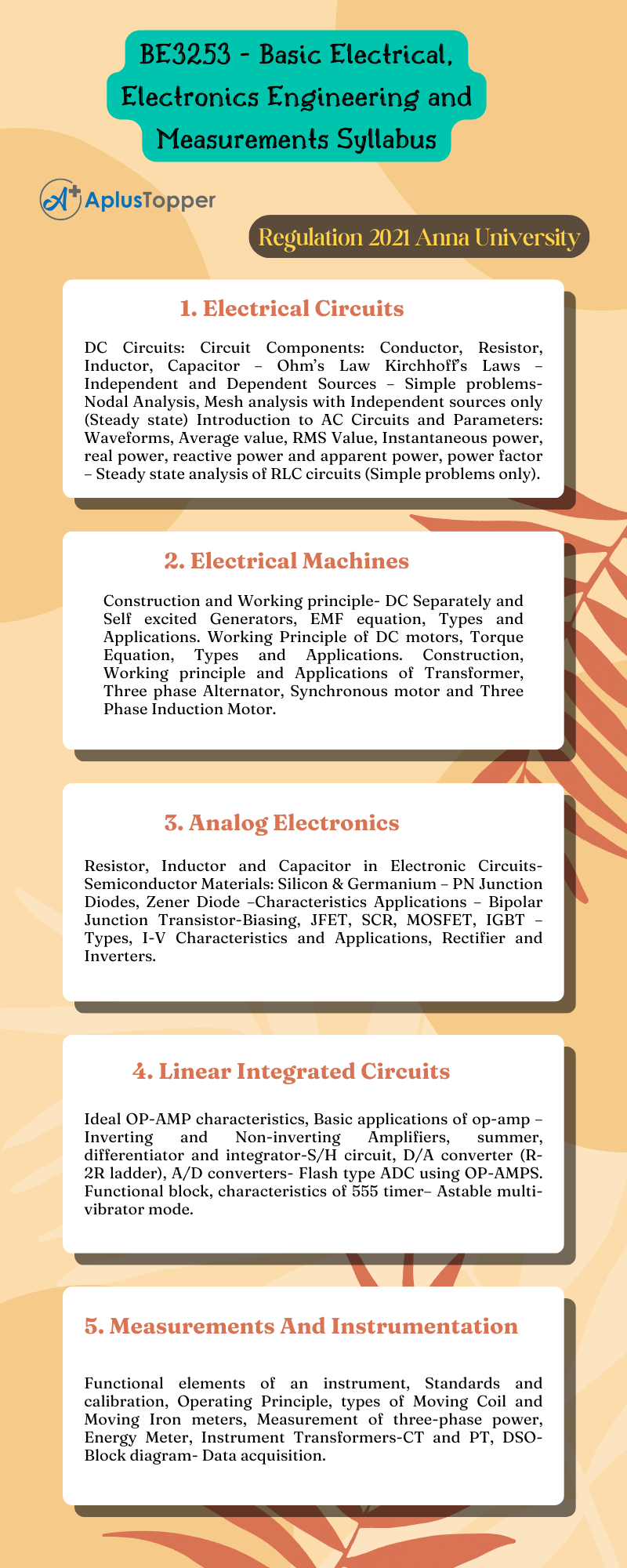BE3253 deals with the semester II B.E Robotics and Automation Syllabus at Anna University based on regulation 2021. In this article, we discuss the Basic Electrical, Electronics Engineering, and Measurements syllabus along with textbooks and references.
We intend to provide a full-planned syllabus for students to gain knowledge of the syllabus. It will give students to be equipped with perfect books and the required knowledge to prepare for the examinations. These are necessary to get a qualified certificate from the university with aggregate marks. Students must perform well to take a step forward toward their careers. They must earn a qualified degree help them to achieve success in their goals. In this article, BE3253 – Basic Electrical, Electronics Engineering, and Measurements Syllabus will pioneer the way to do that. Hope the following information is useful. Don’t forget to share it with your classmates.
If you want to know more about the syllabus of B.E Robotics and Automation connected to an affiliated institution’s four-year undergraduate degree program. We provide you with a detailed Year-wise, semester-wise, and Subject-wise syllabus in the following link B.E Robotics and Automation Syllabus Anna University, Regulation 2021.
Aim Of Objectives:
- To introduce the basics of electric circuits and analysis.
- To impart knowledge in the basics of working principles and application of electrical machines.
- To introduce analog devices and their characteristics.
- To educate on the fundamental concepts of linear integrated circuits.
- To introduce the functional elements and working of measuring instruments.
BE3253 – Basic Electrical, Electronics Engineering and Measurements Syllabus
Unit I: Electrical Circuits
DC Circuits: Circuit Components: Conductor, Resistor, Inductor, Capacitor – Ohm’s Law Kirchhoff’s Laws –Independent and Dependent Sources – Simple problems- Nodal Analysis, Mesh analysis with Independent sources only (Steady state) Introduction to AC Circuits and Parameters: Waveforms, Average value, RMS Value, Instantaneous power, real power, reactive power and apparent power, power factor – Steady state analysis of RLC circuits (Simple problems only).
Unit II: Electrical Machines
Construction and Working principle- DC Separately and Self excited Generators, EMF equation, Types and Applications. Working Principle of DC motors, Torque Equation, Types and Applications. Construction, Working principle and Applications of Transformer, Three phase Alternator, Synchronous motor and Three Phase Induction Motor.
Unit III: Analog Electronics
Resistor, Inductor and Capacitor in Electronic Circuits- Semiconductor Materials: Silicon & Germanium – PN Junction Diodes, Zener Diode –Characteristics Applications – Bipolar Junction Transistor-Biasing, JFET, SCR, MOSFET, IGBT – Types, I-V Characteristics and Applications, Rectifier and Inverters.

Unit IV: Linear Integrated Circuits
Ideal OP-AMP characteristics, Basic applications of op-amp – Inverting and Non-inverting Amplifiers, summer, differentiator and integrator-S/H circuit, D/A converter (R- 2R ladder), A/D converters- Flash type ADC using OP-AMPS. Functional block, characteristics of 555 timer– Astable multi-vibrator mode.
Unit V: Measurements And Instrumentation
Functional elements of an instrument, Standards and calibration, Operating Principle, types of Moving Coil and Moving Iron meters, Measurement of three-phase power, Energy Meter, Instrument Transformers-CT and PT, DSO- Block diagram- Data acquisition.
Text Books:
- D P Kothari and I.J Nagrath, “Basic Electrical and Electronics Engineering”, McGraw Hill Education, Second Edition, 2020.
- Allan S Moris, “Measurement and Instrumentation Principles”, Third Edition, Butterworth Heinemann, 2001.
- S.K. Bhattacharya, Basic Electrical Engineering, Pearson Education, 2019
- James A . Svoboda, Richard C. Dorf, “Dorf’s Introduction to Electric Circuits”, Wiley, 2018.
References:
- Thomas L. Floyd, ‘Electronic Devices’, 10th Edition, Pearson Education, 2018.
- A.K. Sawhney, Puneet Sawhney ‘A Course in Electrical & Electronic Measurements & Instrumentation’, Dhanpat Rai and Co, New Delhi, January 2015.
- Albert Malvino, David Bates, ‘Electronic Principles, McGraw Hill Education; 7th edition, 2017.
Related Posts On Semester – II:
- HS3252 Professional English – II
- MA3251 Statistics and Numerical Methods
- GE3251 Engineering Graphics
- GE3252 தமிரு் ததொழி்நு்பமு் /Tamils and Technology
Also Check:
